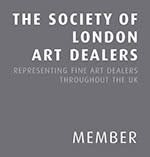-
 Arthur DoveLandscape, 1941gouache and ink on paper12.7 x 17.8 cmSold
Arthur DoveLandscape, 1941gouache and ink on paper12.7 x 17.8 cmSold
5 x 7 in -
 Arthur DoveLandscape, 1933Watercolour and ink on paper12.7 x 17.8 cmSold
Arthur DoveLandscape, 1933Watercolour and ink on paper12.7 x 17.8 cmSold
7 x 5 in -
 Arthur DoveThe Other Farm, 1934watercolour and ink on paper12.7 x 17.8 cm
Arthur DoveThe Other Farm, 1934watercolour and ink on paper12.7 x 17.8 cm
5 x 7 in -
 Arthur DoveUntitled, 1941Gouache and ink on paper10 x 14 cmSold
Arthur DoveUntitled, 1941Gouache and ink on paper10 x 14 cmSold
4 x 5.5 in -
 Arthur DoveUntitled #18, 1941watercolor and ink on paper laid down on card10.2 by 13.2 cmSold
Arthur DoveUntitled #18, 1941watercolor and ink on paper laid down on card10.2 by 13.2 cmSold
4 x 5.5 in -
 Arthur DoveUntitled (Abstraction IV Geometric), 1941Watercolor on paper10.2 by 13.2 cm
Arthur DoveUntitled (Abstraction IV Geometric), 1941Watercolor on paper10.2 by 13.2 cm
4 x 5.5 in
Arthur Garfield Dove was an early American modernist painter. After finishing his studies at Cornell University, Dove worked as an illustrator for magazines such as Harper’s Magazine and The Saturday Evening Post in New York City. In 1907, Dove and his first wife Florence moved to Paris. They took frequent trips all over Europe which installed a modern sensibility in Dove’s practise, with a particular interest in the Fauvist movement. Dove became close friends with a group of experimental American artists, in particular the painter Alfred Maurer who would become a life long friend.
On his return to New York, a dissatisfaction began to grow with his work as an illustrator. Eventually Dove moved to the countryside where, working as a farmer and fisherman, he began his work on what would later be described as America’s first abstract paintings. “Extractions”, as he put it, simplified shapes seen in nature into abstract forms. Under the helm of Alfred Stieglitz at 291 Gallery, a group of other pioneering artists including Dove, would directly impact the major American art movements of the 20th century. The initial European influence began to evolve into a completely American vision of art, which has undergone a major re-evaluation over the last decade.
Dove’s work, though ground breaking in its day, still shares a contemporary sensibility. Comparisons can be drawn with the dramatic shifts the turn of the century and industrial revolutions had in that period with what we are experiencing today.
-

Arthur Dove: Extraction, not Abstraction
1 May - 5 Jul 2024Recognised as a significant figure in the history of modern art in the United States, Arthur Dove (1880 - 1946) pioneered a new artistic language for the twentieth century and...Read more -

James Ward presents: Seven Americans
A Contemporary Exploration of American Modernism 22 Jan - 27 Apr 2024In 1925, well-known gallerist and photographer Alfred Stieglitz held an exhibition at his 291 gallery in NYC, calling the exhibition ‘Seven Americans’. It was ground-breaking in its approach to embrace...Read more -

James Ward presents: American Modernism
17 Jul - 30 Sep 2023Modernism swept across the world in the early part of the 20th Century originating in Europe with a group of pioneering artists whose ground breaking ideas would shape the world...Read more
-

Arthur’s Gone Out Prowling
by William Davie June 17, 2024At a glance, Arthur Dove’s forlorn landscape ‘The Other Farm’ (1934), appears to be nothing more than a hastily executed study. Around 1930, Dove began...Read more -

Arthur Garfield Dove (2 August 1880 - 23 November 1946)
by Lilly Dawson April 29, 2024Nature and emotion so dominated the subject matter of Arthur Garfield Dove’s modernist output, that he has been credited as the first American abstract artist...Read more -

All ways are right: Stieglitz and the Seven Americans
by Lilly Dawson January 16, 2024Alfred Stieglitz was both a giant of 20th century photography and a relentless promoter of Modernism in America through three iterations of his New York...Read more -

Alfred Stieglitz and The Stieglitz Circle
by Lilly Dawson June 1, 2023As the 20th Century dawned, a new generation of American artists found themselves drawn to a profoundly new form of modernism. Cubism was rapidly becoming...Read more














